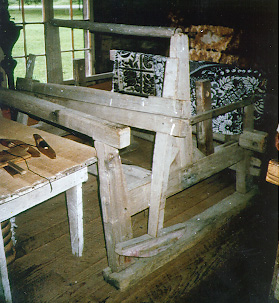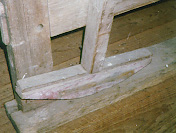|
|
At Right: Detail view of rocker. Rockers are held in place on the base of the loom using the peg-in-hole method. There are four pegs on the underside of the rocker, and corespondiung holes in the base of the loom. This loom was brought to Melrose Plantation in 1898, by Cammie Garrett, wife of John Hampton Henry. It was one of several looms at the plantation and, since it had been moved from Acadia Parish, it became known as the Acadian loom. The loom had been in Cammie's family for over 100 years at the time of its relocation to Melrose Plantation. Cammie's mother was an Erwin whose grandfather had migrated from North Carolina to Nashville Tennessee in 1790. The family then left Tennessee for Louisiana, in 1806, after a son-in-law, Charles Dickinson, was killed in a dual with Andrew Jackson. Melrose Plantation is now a National Historic Landmark, preserved as one of the unique plantations of the Old South. It was well-established as a sugar cane and cotton plantation when the Henry's bought it in 1898, and 'Miss Cammie' focused her energy on bringing it back to its former beauty and making it a repository of local arts and crafts, history, and legend. |
 Above: Wide view of front-right
side of loom. Loom is set up, but unwarped. Note the
secondary set of uprights directly behind the main set.
About half as tall, they appear to be bored for an extra
beam.
Above: Wide view of front-right
side of loom. Loom is set up, but unwarped. Note the
secondary set of uprights directly behind the main set.
About half as tall, they appear to be bored for an extra
beam.